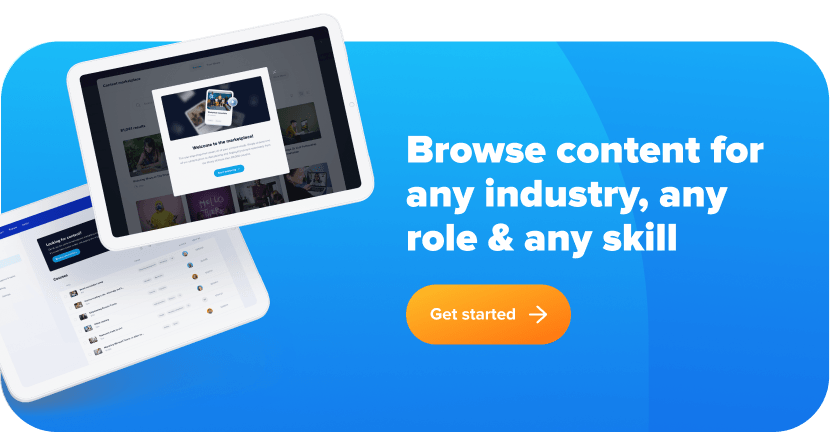There are a couple of versions to be aware of. The most widely used, SCORM 1.2, focuses on interoperability, enabling content created in one system to be used across various SCORM-compliant LMS software. It allows basic tracking of learner progress, such as completion rates, pass/fail status, and scores.
SCORM 2004, the more advanced version, introduced better sequencing and navigation control. It allows for more sophisticated tracking, including how learners navigate through content, the time spent on different sections, and even branching scenarios based on learner input.
We’re breaking down what it means to have a SCORM-compliant LMS, why it matters, the key features to look for, and how to ensure your chosen LMS meets the needs of your organization.
What is a SCORM-compliant LMS?
SCORM was developed to solve the problem of interoperability, allowing learning content and LMS platforms to stay on the same page (so to speak) and communicate seamlessly. By packaging learning modules in a standardized format, SCORM makes sure that content developed in one system can function in another without needing major reconfiguration. At its core, SCORM ensures:
- SCORM-compliant content is wrapped into a package that can be shared easily between systems. It uses a ZIP file known as a Package Interchange Format (PIF), which contains all the necessary components for an LMS to read and execute the course.
- Learning and training content records and tracks data about learner progress, results, and completion back to the LMS, allowing for accurate tracking and reporting.
This means if an organization chooses to switch LMS providers, they can migrate existing SCORM-compliant content without needing to rebuild the course. A SCORM-compliant LMS therefore facilitates consistency across platforms and reduces the friction that is often present during platform changes.
Why SCORM compliance matters
Whether you’re a small business or a global enterprise, SCORM makes sure that your digital learning programs are scalable and reusable, as well as being easy to manage. SCORM compliance matters because:
- SCORM-compliant content works across multiple platforms, so even if you change your LMS provider, your learning materials remain intact.
- SCORM allows organizations to reuse content across different departments or business units. Once you have SCORM-compliant training modules, they can be redeployed in various parts of your organization without needing to recreate or modify them.
- SCORM keeps the learning experience consistent for all users. By standardizing how content behaves on different systems, learners across departments or regions can access the same training content.
SCORM-compliant LMS platforms can track detailed learner performance data, providing insights into user progress and course completion.

Key features of a SCORM-compliant LMS
If you’re looking for a SCORM-compliant LMS, you may ask yourself ‘what features do I need to be looking out for?’. There are a handful of key features that a SCORM-compliant LMS should have, which will help to give you confidence in the platform of choice.
SCORM content packaging
SCORM content packaging allows courses to be uploaded, launched, and managed within an LMS, offering a streamlined and scalable way to manage learning content. This should include supporting different SCORM versions, such as SCORM 1.2 and SCORM 2004.
Advanced tracking and reporting
User data such as course progress, completion rates and quiz scores should all be trackable, enabling you to run detailed reports to evaluate the effectiveness of the training.
Cross-device compatibility
Content should be accessible across various devices (desktops, tablets, mobile phones etc.) so that learning is flexible for employees, allowing them to complete training on-the-go.
Accessibility
A SCORM-compliant platform should be easy to use and accessible for learners with diverse needs, keeping compliance with international accessibility standards. Courses should be simple to find and navigate to, personal information should be readily accessible, and users should be able to complete their assigned training without any blockers.
Ease of course distribution
A SCORM-compliant LMS simplifies the creation and distribution of courses as once a course is packaged according to SCORM standards, the content can be shared across teams, regions, or departments without any hassle.
How to choose a SCORM-compliant LMS
To help you navigate the many available options, here’s a quick guide to choosing the best SCORM-compliant LMS for your organization.
1. Determine the SCORM versions you need
While SCORM 1.2 covers the basics of content interoperability and learner tracking, SCORM 2004 offers more advanced features, such as content sequencing and better tracking of learner progress. That being said, SCORM 1.2 is the most widely used.Check if the SCORM-compliant LMS software you’re considering supports both versions to maintain flexibility and compatibility with your content.
2. Check for ADL certification
The Advanced Distributed Learning (ADL) initiative oversees SCORM standards, and an ADL-certified LMS has been tested to ensure full compliance with SCORM. While many platforms claim SCORM compatibility, an ADL-certified LMS guarantees adherence to the standards.
3. Understand your reporting requirements
Not all LMS platforms present reporting data in the same way, so you’ll need to consider how important reporting is for your needs. Do you need basic tracking like completion status and scores? Or do you require more advanced analytics, such as learner behavior, progression through modules, and compliance tracking?
4. Customer support and training
A good LMS provider should offer ongoing customer support, especially when dealing with SCORM. Whether it’s integrating new SCORM packages or troubleshooting issues with content reporting, ensure that the LMS vendor provides:
- 24/7 support.
- Detailed documentation and tutorials on SCORM functionality.
- Options for training administrators and instructors.
5. Do you foresee expansion and require scalability?
If you anticipate that your organization’s learning needs will grow, look for a SCORM-compliant learning management system that is scalable. Whether you need to accommodate more learners, courses, or integrate with other systems like HR platforms, a flexible LMS that can scale with your organization ensures a future-proof investment.
SCORM vs xAPI: Is xAPI replacing SCORM?
xAPI, or Experience API, is a modern specification designed to track and record a wide range of learning experiences, both online and offline. While SCORM tracks basic learner activities such as course completion and time spent on a module, xAPI takes this a step further, with the ability to capture a richer data set to give organizations a more comprehensive view of the learner’s journey, providing additional insights.
As well as tracking learner progress, xAPI arguably has the upperhand in data flexibility (essentially the capacity for data to adapt to changing application needs). xAPI can track learning in a more holistic manner, perhaps making it a better fit for organizations that want to measure learning activities across multiple contexts and devices, rather than only an LMS.
However, is it realistic to think that xAPI will replace SCORM? The reality is that SCORM is well-established and supported by nearly all LMS platforms, making it a reliable and widely accepted choice for organizations. Many organizations continue to rely on SCORM, while others are beginning to incorporate both SCORM and xAPI to leverage the strengths of each standard. It all depends on the complexity and detail required for your employee training.
Launching your LMS
With features like content reuse, advanced reporting, and cross-platform compatibility, SCORM makes sure that your training initiatives can grow alongside your business needs. By staying SCORM-compliant, your organization can streamline its learning efforts and provide a consistent, high-quality training experience across the board.
eloomi is a SCORM-compliant LMS that offers an all-in-one platform covering onboarding, skill development, compliance training and more. Explore the eloomi LMS today.







